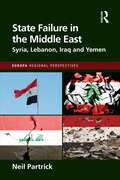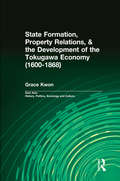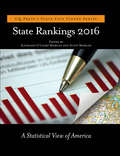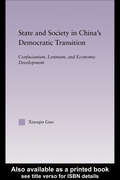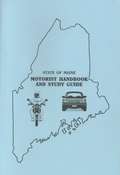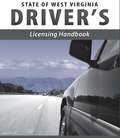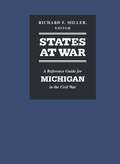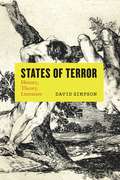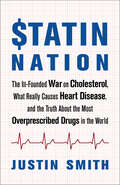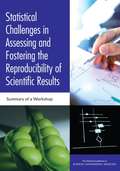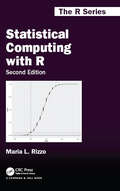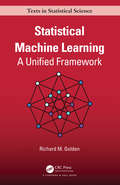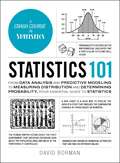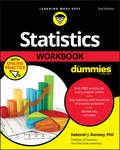- Table View
- List View
State Failure in the Middle East: Syria, Lebanon, Iraq and Yemen (Europa Regional Perspectives)
by Neil PartrickThe collapse of the regime of Bashar al-Assad in Syria begs the question as to why that country so lacked institutional and organized capacity that the Syrian state melted away. In neighbouring Lebanon, the state has been absent in any meaningful sense for much of the country’s independent history, while powerful sectarian interest groups dominate governance and maintain their own armed options. In Iraq, the state has collapsed twice since the US-led invasion of 2003 and is currently existing in parallel with armed sectarian militias whose political wings utilize governmental apparatus to further their narrow interests. In Yemen, there is no single state encompassing its internationally recognized boundaries, but instead there are three competing authorities ruling different parts of the country.This book assesses why the state is failing in these four particular cases and, where relevant, examines common explanatory themes, while remaining mindful of each country’s distinct domestic and international context. Much of the material is based on research carried out in the countries themselves, involving interviews with existing or former state officials, their advisers, senior analysts, or those seeking state authority. Through this process a debate is conducted as to where power lies in each of the four cases.This book will be invaluable for anyone seeking to understand how the state does, or rather does not, operate, in these four Middle Eastern examples, including academics, students and postgraduates, and professionals with an interest in the Middle East.
State Formation, Property Relations, & the Development of the Tokugawa Economy (East Asia: History, Politics, Sociology and Culture)
by Grace KwonBefore the late 1960s, Japan historians characterized the Early Modern Japanese economy in waht are typical feudal terms. Considered backward and stagnant, it was argued that the economy eventually collapsed under the weight of its own internal limitations. This narrative has given way in the past two decades to a new interpretation in which Japan's pre-industrial economy is protrayed as one of substantive growth and qualitative change, the setting stage for modern development during the Meiji era.
State Rankings 2016: A Statistical View of America
by Kathleen O'Leary Morgan Scott MorganPublished annually, State Rankings features comprehensive state statistics making it easy to compare states across key measures in education, health, crime, transportation, taxes, government finance, and so much more. The editors compile useful statistics that would otherwise take an enormous amount of time to research making it a favorite resource on reference shelves throughout the United States and around the world. The rankings have been updated using specific methodology explained in the introduction. Geographic and data notes are also included to provide context. State Rankings compares every state and Washington, DC, in the following areas: - Agriculture - Population - Economy - Environment - Government finance - Crime - Education - Geography - Social welfare - Defense - Health - Energy - Housing
State Rankings 2018: A Statistical View of America
by Scott Morgan Kathleen O’Leary MorganPublished annually, State Rankings features comprehensive state statistics across key measures in education, health, crime, transportation, taxes, government finance, and so much more. The editors compile useful statistics that otherwise take an enormous amount of time to research, making it a favorite resource on reference shelves throughout the United States and around the world. Overall state rankings are provided as well as a complete list of all sources used to compile the tables. The rankings have been updated using specific methodology explained in the introduction with the most current available data at publication. Explanatory notes on the source and data are also included to provide context to each statistical table. State Rankings compares every state and Washington, D.C. in the following areas: Agriculture Population Economy Environment Government finance Crime Education Geography Social welfare Defense
State and Society in China's Democratic Transition: Confucianism, Leninism, and Economic Development
by Xiaoqin GuoThis study aims to fill the gap in the existing literature on China's Democratic development, by presenting a comprehensive and detailed examination of the key factors that have created and sustained state domination over society in China.
State of Maine Motorist Handbook and Study Guide
by State of Maine Bureau of Motor Vehicles<p>One of life's great rites of passage is obtaining our first driver's license. It represents a milestone in independence; indeed, with the invention of the automobile, the ability to operate a motor vehicle represents the greatest level of freedom, flexibility, and mobility in human history. As exciting as having a valid license and a dependable motor vehicle can be, great danger awaits the unwary motorist. Let us never forget that we are driving a two thousand pound piece of steel. We must be vigilant, at all times, in our attention to driving to protect not only ourselves, but all others who are sharing Maine's roadways. <p>As you review and learn the contents of this manual, it is important to keep in mind that everything around you as a driver--from the painted lines in the road, the road signs, traffic control lights and rumble strips to the safety belts, directional signals, airbags, and anti-lock brakes--has been developed and mandated for use because, in their absence, someone died. While these devices greatly enhance the odds of emerging safely from a crash, the most critical component is the skill of the operator. That's where you come in.<p>
State of New Hampshire Driver Manual
by New Hampshire Department of SafetyState of New Hampshire Driver Manual
State of New Hampshire Driver's Manual 2018
by State of New Hampshire Department of SafetyState of New Hampshire Driver's Manual
State of New Hampshire Drivers Manual 2013
by Department of Safety Division of Motor VehiclesThe laws, rules and regulations that directly or indirectly effect the operator of the motor vehicle, so one may fully enjoy the privilege of driving.
State of West Virginia Driver's Licensing Handbook
by Department of Transportation State of West Virginia<p>The driver examination program provides fundamental education in traffic safety and allows you to match your driving ability with accepted standards for safe driving. <p>This manual is only a partial digest of West Virginia motor vehicle laws. As a prospective driver, you should become familiar with all of the information in this manual. It will enable you to pass the driver examination and help you become a good driver.
State of West Virginia Driver's Licensing Handbook
by West Virginia Department of TransportationState of West Virginia Driver's Licensing Handbook
State of West Virginia Driver's Licensing Handbook
by West Virginia Division of Motor VehiclesThis handbook is designed to provide you with the information you need to obtain and keep a Class E driver's license. This handbook guides you in following the laws and rules of the road, explains the best practices necessary to avoid crashes, and encourages consideration for the rights of all users of the highways.
State, society and mobilization in Europe during the First World War
by John HorneThis volume examines political and cultural mobilisation in the face of industrialised mass death during the First World War. Comparing Britain, France, Germany, Italy and Austria-Hungary, it generates arguments on mobilisation and 'total war' which have wider relevance. It explores 'national ideals' which cast the war as a crusade, the inclusive 'self-mobilisation' of sectional identities and private organisations behind national efforts, and the exclusion of suspect groups (the 'enemy within') from the mobilisation process. It also highlights the importance, and difficulty, of assessing the limits of mobilisation as well as the differing capacities of the state to sustain it, factors related to prior degrees of national integration and political legitimacy. Mobilisation in this sense was an important factor which determined the outcome and legacy of the war.
States Undermining International Law: The League of Nations, United Nations, and Failed Utopianism (Philosophy, Public Policy, and Transnational Law)
by Deepak MawarThis book analyses the history of international law to reveal the significant role utopianism has played in developing the international legal system. In fact, when pinpointing the legal system’s most accelerated phases of development, it becomes increasingly apparent how integral utopianism has been in dealing with the international community’s most troubled periods such as the World Wars. However, States have on numerous occasions undermined utopianism, leading to situations where individuals and communities have been vulnerable to modes of oppression such as war or repressive regimes. Thus, by examining the League of Nations and United Nations, this book seeks to show why utopianism continues to be a vital ingredient when the international community is seeking to ensure its loftiest and most ambitious goals such as maintaining international peace and security, and why for the sake of such utopian aspirations, the primary position States enjoy in international law requires reassessment.
States at War: A Reference Guide for Michigan in the Civil War (States At War Ser.)
by Richard F MillerUnlike most books about the Civil War, which address individual battles or the war at the national level, States at War: A Reference Guide for Michigan in the Civil War chronicles the actions of an individual state government and its citizenry coping with the War and its ramifications, from transformed race relations and gender roles, to the suspension of habeas corpus, to the deaths of over 10,000 Michigan fathers, husbands, sons, and brothers who had been in action. The book compiles primary source material—including official reports, legislative journals, executive speeches, special orders, and regional newspapers—to provide an exhaustive record of the important roles Michigan and Michiganders had in the War. Though not burdened by marching armies or military occupation like some states to the southeast, Michigan nevertheless had a fascinating Civil War experience that was filled with acute economic anxieties, intense political divisions, and vital contributions on the battlefield. This comprehensive volume will be the essential starting point for all future research into Michigan’s Civil War-era history.
States of Terror: History, Theory, Literature
by David SimpsonHow have we come to depend so greatly on the words terror and terrorism to describe broad categories of violence? David Simpson offers here a philology of terror, tracking the concept’s long, complicated history across literature, philosophy, political science, and theology—from Plato to NATO. Introducing the concept of the “fear-terror cluster,” Simpson is able to capture the wide range of terms that we have used to express extreme emotional states over the centuries—from anxiety, awe, and concern to dread, fear, and horror. He shows that the choices we make among such words to describe shades of feeling have seriously shaped the attribution of motives, causes, and effects of the word “terror” today, particularly when violence is deployed by or against the state. At a time when terror-talk is widely and damagingly exploited by politicians and the media, this book unpacks the slippery rhetoric of terror and will prove a vital resource across humanistic and social sciences disciplines.
Statin Nation: The Ill-Founded War on Cholesterol, What Really Causes Heart Disease, and the Truth About the Most Overprescribed Drugs in the World
by Justin SmithA new understanding of heart disease and an innovative path to a viable alternative model to address the real causes of heart disease.Heart disease is the leading cause of death worldwide, and for decades conventional health authorities have pushed that the culprits are fat and cholesterol clogging up coronary arteries. Consequently, lowering cholesterol has become a hugely lucrative business, and cholesterol-lowering Statin drugs are now the most prescribed medication in the world, with clinical data showing one billion people eligible for prescription. However, these cholesterol guidelines have been heavily criticized, and increasingly, doctors and researchers have been questioning the role cholesterol plays in heart disease. We now know that people with heart disease often do not, in fact, have high cholesterol, and even the strongest supporters of the cholesterol hypothesis now admit that no ideal level of cholesterol can be identified.Large-scale studies have proven that statins are not generating the benefits that were predicted, and new research shows that high cholesterol may actually prevent heart disease. Worse still, millions of people in the United States and worldwide are taking statins preventatively, at great cost to their health. A complete reevaluation of the real causes of heart disease is long overdue, not to mention an inquiry into why the pharmaceutical industry continues to overprescribe statins (and market them aggressively to consumers) despite this evidence.Statin Nation offers a new understanding of heart disease, and Justin Smith forges an innovative path away from the outdated cholesterol myth with a viable alternative model to address the real causes of heart disease. Statin Nation provides detailed examinations of nutritional alternatives that are up to six times more effective than statins, and other interventions that have been shown to be up to eleven times more effective than statins. But all of these methods are currently ignored by health authorities. Smith provides a heart disease prevention plan that anyone can use, providing hope for the future of heart-disease treatment with a purpose.&“A complete and authoritative explanation of the causes of heart disease. . . This book fills an important need for a comprehensive explanation of the pharmaceutical industry&’s efforts to profit from statin drugs, of the trivial effect on prevention of heart disease by these drugs, and of their serious toxic side effects. More importantly, the book describes the true causes of heart disease and emphasizes optimal nutrition as the correct approach to prevention.&”—Kilmer McCully, MD, author of The Heart Revolution
Statistical Challenges in Assessing and Fostering the Reproducibility of Scientific Results: Summary of a Workshop
by Engineering Medicine National Academies of SciencesQuestions about the reproducibility of scientific research have been raised in numerous settings and have gained visibility through several high-profile journal and popular press articles. Quantitative issues contributing to reproducibility challenges have been considered (including improper data measurement and analysis, inadequate statistical expertise, and incomplete data, among others), but there is no clear consensus on how best to approach or to minimize these problems. A lack of reproducibility of scientific results has created some distrust in scientific findings among the general public, scientists, funding agencies, and industries. While studies fail for a variety of reasons, many factors contribute to the lack of perfect reproducibility, including insufficient training in experimental design, misaligned incentives for publication and the implications for university tenure, intentional manipulation, poor data management and analysis, and inadequate instances of statistical inference. The workshop summarized in this report was designed not to address the social and experimental challenges but instead to focus on the latter issues of improper data management and analysis, inadequate statistical expertise, incomplete data, and difficulties applying sound statistic inference to the available data. Many efforts have emerged over recent years to draw attention to and improve reproducibility of scientific work. This report uniquely focuses on the statistical perspective of three issues: the extent of reproducibility, the causes of reproducibility failures, and the potential remedies for these failures.
Statistical Computing with R, Second Edition (Chapman & Hall/CRC The R Series)
by Maria L. RizzoComputational statistics and statistical computing are two areas that employ computational, graphical, and numerical approaches to solve statistical problems, making the versatile R language an ideal computing environment for these fields. This second edition continues to encompass the traditional core material of computational statistics, with an
Statistical Concepts For The Behavioral Sciences
by Harold O. Kiess Bonnie A. GreenThis text emphasizes contemporary research problems to better illustrate the relevance of statistical analysis in scientific research. All statistical methods are introduced in the context of a realistic problem, many of which are from contemporary published research. Visit Bonnie and Hal's Statistical Sage Blog which includes helpful information on teaching and engaging students in your undergraduage statistics course! Click here:http://statisticalsage. wordpress. com/
Statistical Machine Learning: A Unified Framework (Chapman & Hall/CRC Texts in Statistical Science)
by Richard GoldenThe recent rapid growth in the variety and complexity of new machine learning architectures requires the development of improved methods for designing, analyzing, evaluating, and communicating machine learning technologies. Statistical Machine Learning: A Unified Framework provides students, engineers, and scientists with tools from mathematical statistics and nonlinear optimization theory to become experts in the field of machine learning. In particular, the material in this text directly supports the mathematical analysis and design of old, new, and not-yet-invented nonlinear high-dimensional machine learning algorithms. Features: Unified empirical risk minimization framework supports rigorous mathematical analyses of widely used supervised, unsupervised, and reinforcement machine learning algorithms Matrix calculus methods for supporting machine learning analysis and design applications Explicit conditions for ensuring convergence of adaptive, batch, minibatch, MCEM, and MCMC learning algorithms that minimize both unimodal and multimodal objective functions Explicit conditions for characterizing asymptotic properties of M-estimators and model selection criteria such as AIC and BIC in the presence of possible model misspecification This advanced text is suitable for graduate students or highly motivated undergraduate students in statistics, computer science, electrical engineering, and applied mathematics. The text is self-contained and only assumes knowledge of lower-division linear algebra and upper-division probability theory. Students, professional engineers, and multidisciplinary scientists possessing these minimal prerequisites will find this text challenging yet accessible. About the Author: Richard M. Golden (Ph.D., M.S.E.E., B.S.E.E.) is Professor of Cognitive Science and Participating Faculty Member in Electrical Engineering at the University of Texas at Dallas. Dr. Golden has published articles and given talks at scientific conferences on a wide range of topics in the fields of both statistics and machine learning over the past three decades. His long-term research interests include identifying conditions for the convergence of deterministic and stochastic machine learning algorithms and investigating estimation and inference in the presence of possibly misspecified probability models.
Statistical Modeling for Biomedical Researchers
by William D. DupontThis text will enable biomedical researchers to use a number of advanced statistical methods that have proven valuable in medical research. It is intended for people who have had an introductory course in biostatistics. A statistical software package (Stata) is used to avoid mathematics beyond the high school level. The emphasis is on understanding the assumptions underlying each method, using exploratory techniques to determine the most appropriate method, and presenting results in a way that will be readily understood by clinical colleagues. Numerous real examples from the medical literature are used to illustrate these techniques. Graphical methods are used extensively. Topics covered include linear regression, logistic regression, Poisson regression, survival analysis, fixed-effects analysis of variance, and repeated-measures analysis of variance. Each method is introduced in its simplest form and is then extended to cover situations in which multiple explanatory variables are collected on each study subject.
Statistics 101: From Data Analysis and Predictive Modeling to Measuring Distribution and Determining Probability, Your Essential Guide to Statistics (Adams 101)
by David BormanA comprehensive guide to statistics—with information on collecting, measuring, analyzing, and presenting statistical data—continuing the popular 101 series. Data is everywhere. In the age of the internet and social media, we’re responsible for consuming, evaluating, and analyzing data on a daily basis. From understanding the percentage probability that it will rain later today, to evaluating your risk of a health problem, or the fluctuations in the stock market, statistics impact our lives in a variety of ways, and are vital to a variety of careers and fields of practice. Unfortunately, most statistics text books just make us want to take a snooze, but with Statistics 101, you’ll learn the basics of statistics in a way that is both easy-to-understand and apply. From learning the theory of probability and different kinds of distribution concepts, to identifying data patterns and graphing and presenting precise findings, this essential guide can help turn statistical math from scary and complicated, to easy and fun. Whether you are a student looking to supplement your learning, a worker hoping to better understand how statistics works for your job, or a lifelong learner looking to improve your grasp of the world, Statistics 101 has you covered.
Statistics Workbook For Dummies with Online Practice
by Deborah J. RumseyPractice your way to a higher statistics score The adage that "practice makes perfect" is never truer than with math problems. Statistics Workbook For Dummies with Online Practice provides succinct content reviews for every topic, with plenty of examples and practice problems for each concept, in the book and online. Every lesson begins with a concept review, followed by a few example problems and plenty of practice problems. There's a step-by-step solution for every problem, with tips and tricks to help with comprehension and retention. New for this edition, free online practice quizzes for each chapter provide extra opportunities to test your knowledge and understanding. Get FREE access to chapter quizzes in an online test bank Work along with each chapter or use the test bank for final exam review Discover which statistical measures are most meaningful Scoring high in your Statistics class has never been easier!
